It is an airplane model made for the first time in a long time. Moreover, it is the first 1/32 scale. I made it in August 2014.
 After a long absence, I wanted to make an airplane and bought it in a flash. It’s the anniversary commemorating the end of the war today for Japan. I intend to make Empire of Japan Navy Interceptor Raiden (Jack) of Hasegawa with the meaning of the requiem all the fallen soldier soul, friend and foe alike.
After a long absence, I wanted to make an airplane and bought it in a flash. It’s the anniversary commemorating the end of the war today for Japan. I intend to make Empire of Japan Navy Interceptor Raiden (Jack) of Hasegawa with the meaning of the requiem all the fallen soldier soul, friend and foe alike.
I think I can assemble it with a similar sense because it’s a 1/32 scale. I’m used to making 1/35 AFV. It’s so long to make an airplane, and now my target is just completion, not to throw it out.
(15-August-2014)
 Now I’m making the cockpit, the assembling is simple, and the mold is excellent. I think I’ll paint detailed parts after some assembly is finished.
Now I’m making the cockpit, the assembling is simple, and the mold is excellent. I think I’ll paint detailed parts after some assembly is finished.
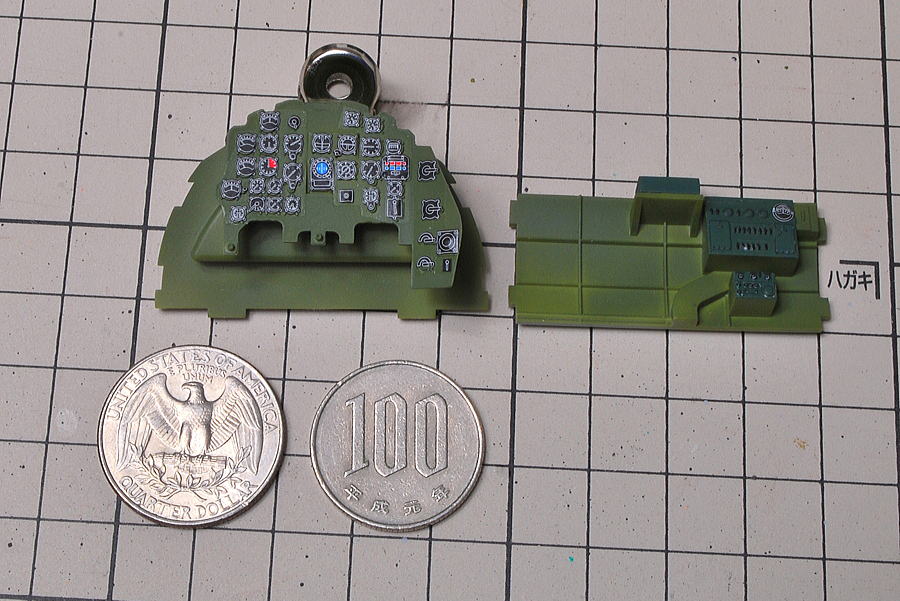 The internal painting, attaching decals of the instrument panel, blowing matte clear. The effectiveness of the panel decal is in this photo. It’s impossible to draw handwriting like this; the decal is very helpful.
The internal painting, attaching decals of the instrument panel, blowing matte clear. The effectiveness of the panel decal is in this photo. It’s impossible to draw handwriting like this; the decal is very helpful.
(15-August-2014)
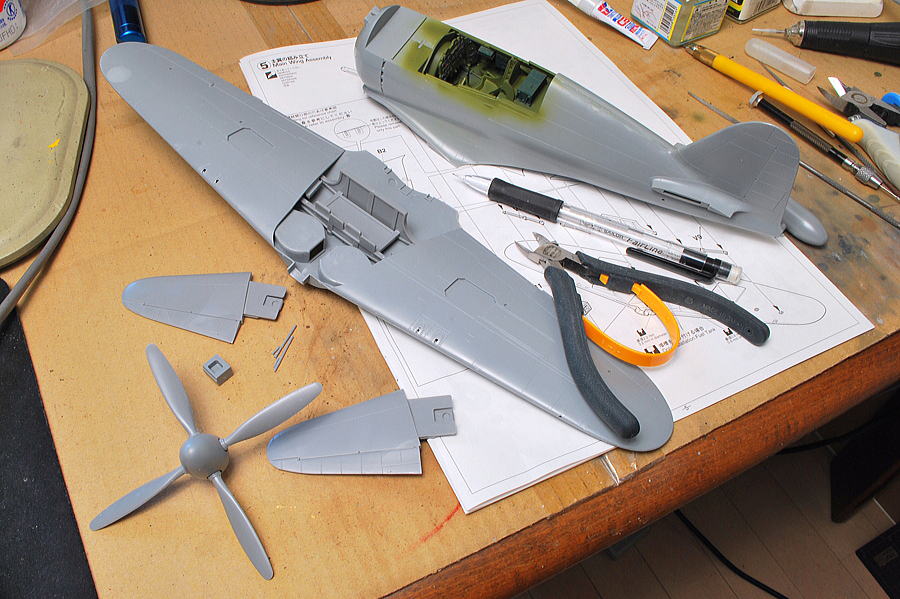 Even if it is a single-engine plane, 1/32 size is huge. I’m wondering where I should display it after completed.
Even if it is a single-engine plane, 1/32 size is huge. I’m wondering where I should display it after completed.
 Photo as assembled roughly. I should decide about the procedure of the painting. I will modify it later if there are gaps.
Photo as assembled roughly. I should decide about the procedure of the painting. I will modify it later if there are gaps.
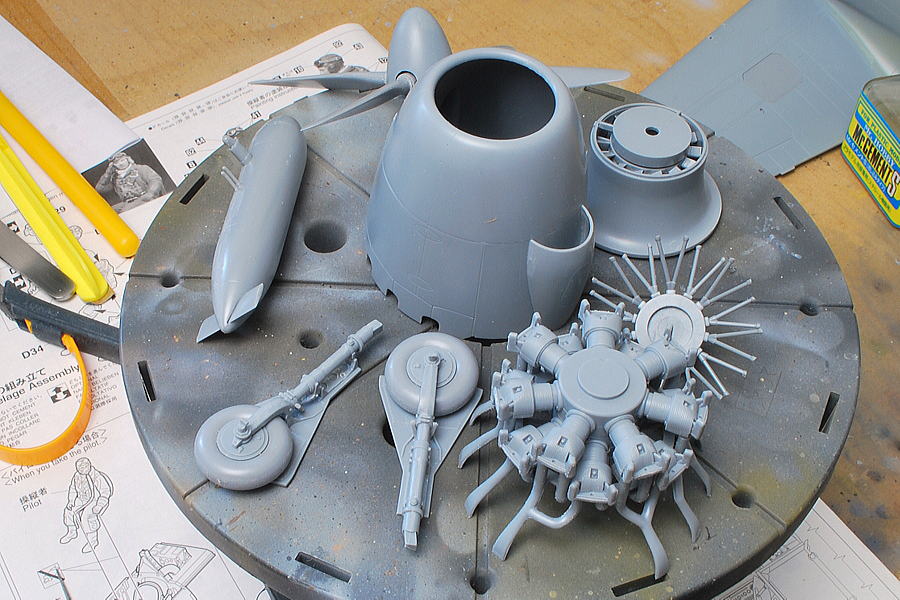 I assembled large parts, an engine, an engine cowl, the belly tank, etc. The engine cannot be seen after all assembled, but it is a perfect proportion.
I assembled large parts, an engine, an engine cowl, the belly tank, etc. The engine cannot be seen after all assembled, but it is a perfect proportion.
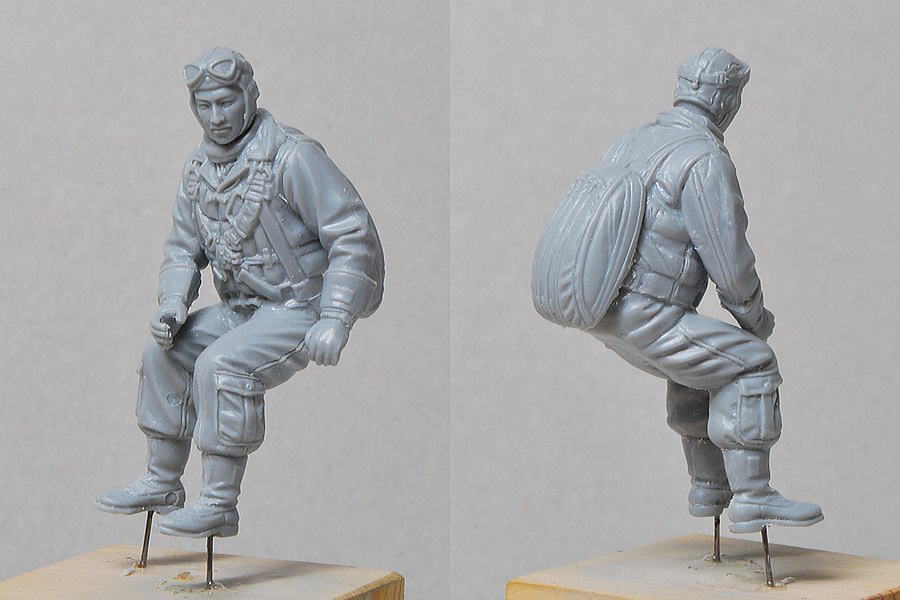 The molding of this figure is splendid. This sculptor also makes the tank crews of the Japanese Imperial Army, which are all excellent. Very nice Asian (Japanese) face. He carries a parachute on his back.
The molding of this figure is splendid. This sculptor also makes the tank crews of the Japanese Imperial Army, which are all excellent. Very nice Asian (Japanese) face. He carries a parachute on his back.
(20-August-2014)
 There are instructions that the two holes for 7.7mm machine guns on the engine cowling should be filled with the other parts. It did not readily fit in perfectly.
There are instructions that the two holes for 7.7mm machine guns on the engine cowling should be filled with the other parts. It did not readily fit in perfectly.
 After I glued the main wing and the body together, there was a large gap because of poor assembling skills. Oh, Hasegawa’s this kit is said it’s good joint every part.
After I glued the main wing and the body together, there was a large gap because of poor assembling skills. Oh, Hasegawa’s this kit is said it’s good joint every part.
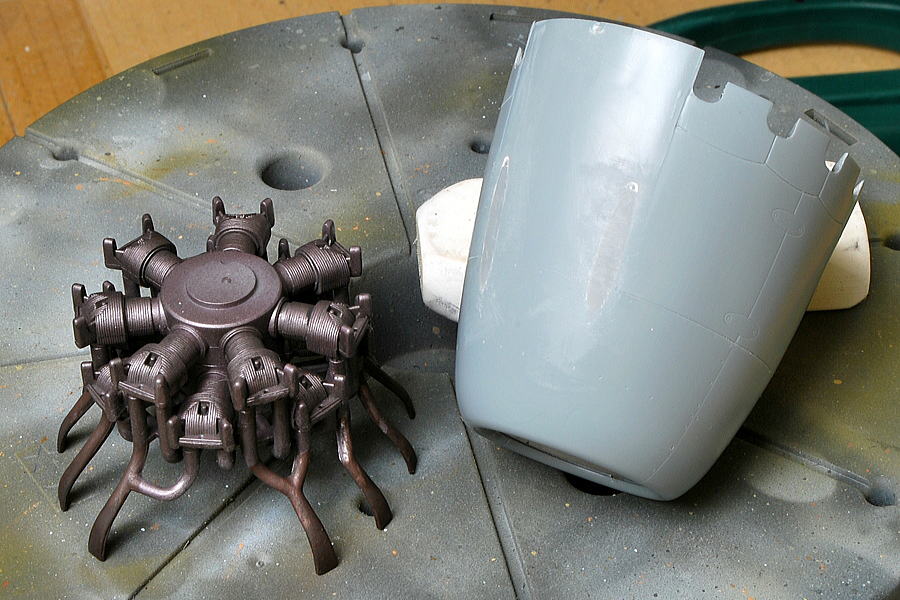 I painted this engine and exhaust pipes. The end of the exhaust pipes is painted a little rusty. I sharpened the engine cowl, but it did not work so smoothly.
I painted this engine and exhaust pipes. The end of the exhaust pipes is painted a little rusty. I sharpened the engine cowl, but it did not work so smoothly.
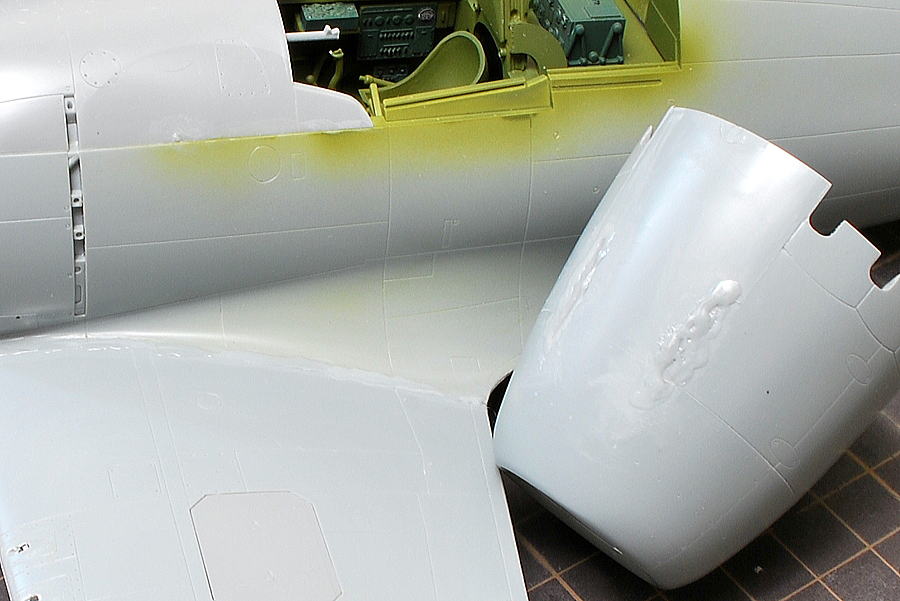 I buried the small gap with putty, and the plastic runner chip melted in the tool cleaner. The trace of the file might not remain because it was made of the same materials as the parts. It takes about three days for complete drying and hardening.
I buried the small gap with putty, and the plastic runner chip melted in the tool cleaner. The trace of the file might not remain because it was made of the same materials as the parts. It takes about three days for complete drying and hardening.
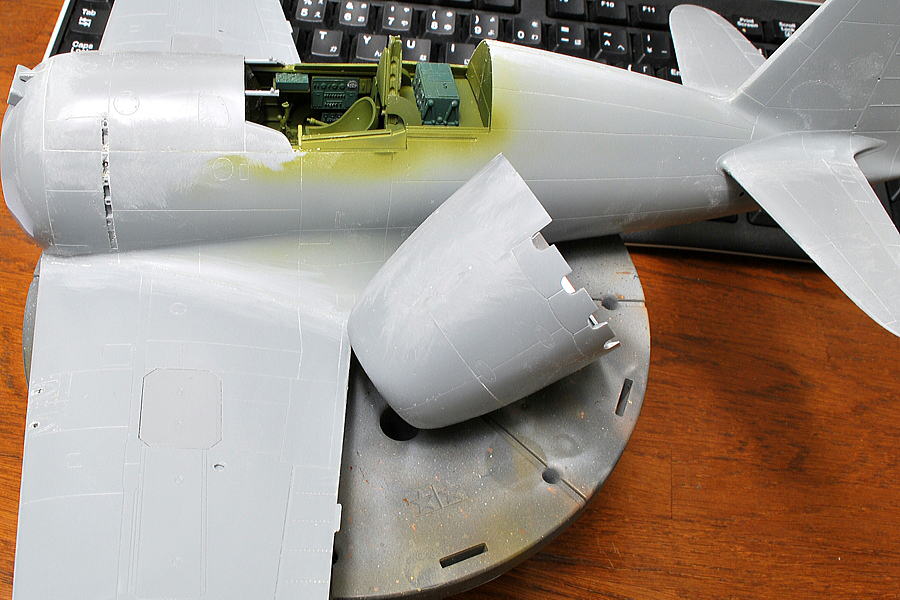 After filing with sandpaper #800, almost a trace disappeared; it’s OK. Usually, I make AFV, and there is not much work; I am weak in filing and polishing.
After filing with sandpaper #800, almost a trace disappeared; it’s OK. Usually, I make AFV, and there is not much work; I am weak in filing and polishing.
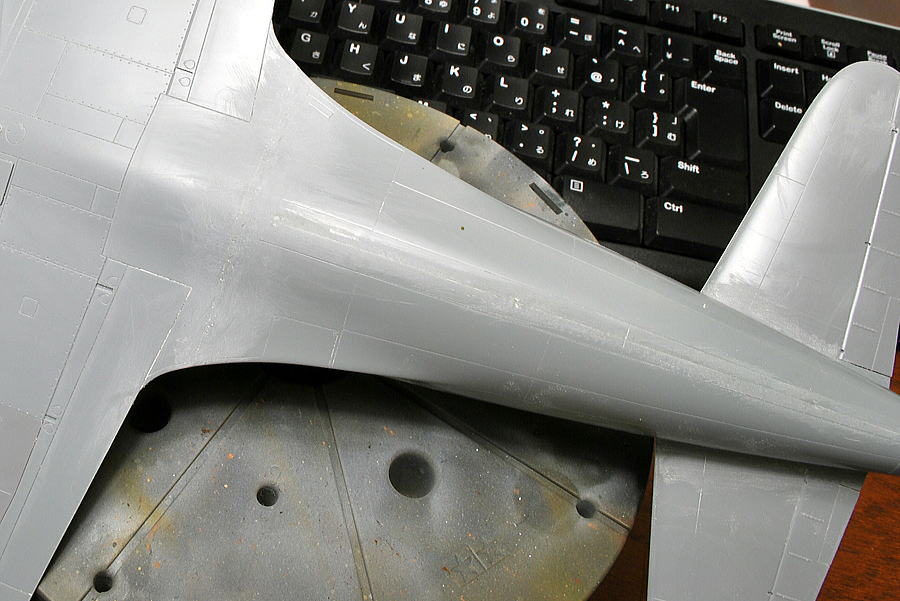 The joints of the backside became beautiful, too. Because I ran out of #1000 and #1200 sandpaper, today’s work is done. More paper filing becomes the area has a smooth surface. I’m worried I’m on the proper procedure of making an airplane. It seems a long way to completion…
The joints of the backside became beautiful, too. Because I ran out of #1000 and #1200 sandpaper, today’s work is done. More paper filing becomes the area has a smooth surface. I’m worried I’m on the proper procedure of making an airplane. It seems a long way to completion…
(30-August-2014)
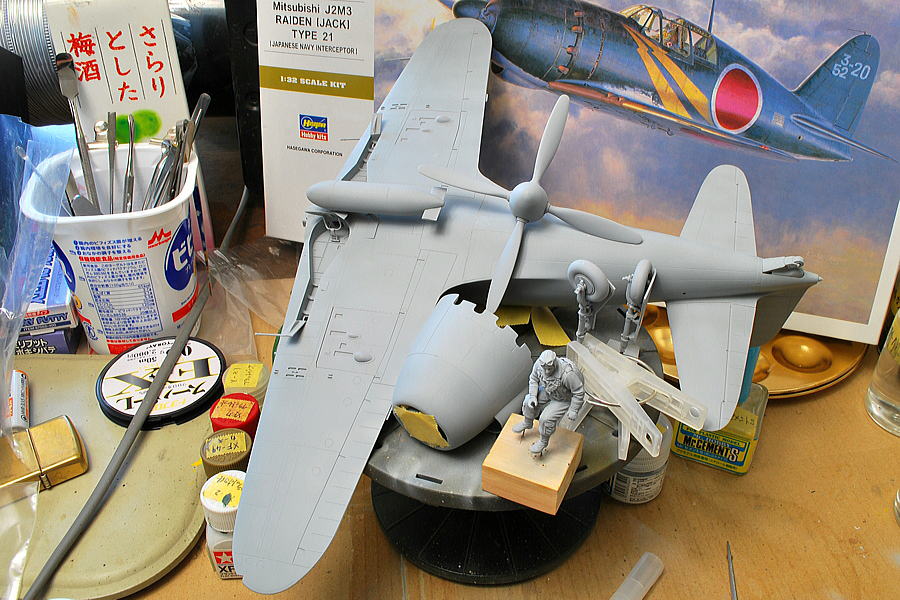 Now I’m thinking it’s time to shift the painting process, so starting to blow the surfacer. Hasegawa’s mold is shallow dent lines but blowing surfacer thinly, no problem.
Now I’m thinking it’s time to shift the painting process, so starting to blow the surfacer. Hasegawa’s mold is shallow dent lines but blowing surfacer thinly, no problem.
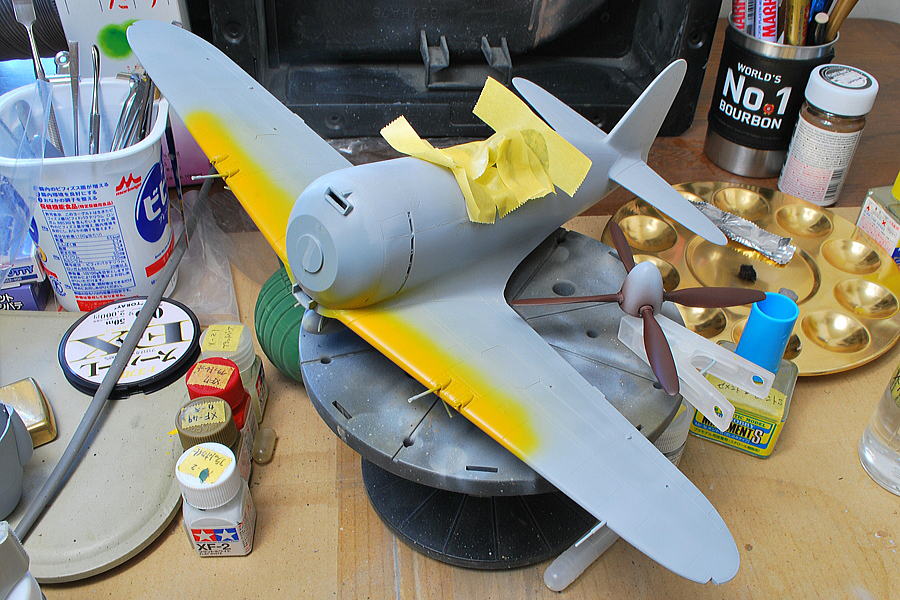 The first part is the yellow belt of the main wing.
The first part is the yellow belt of the main wing.
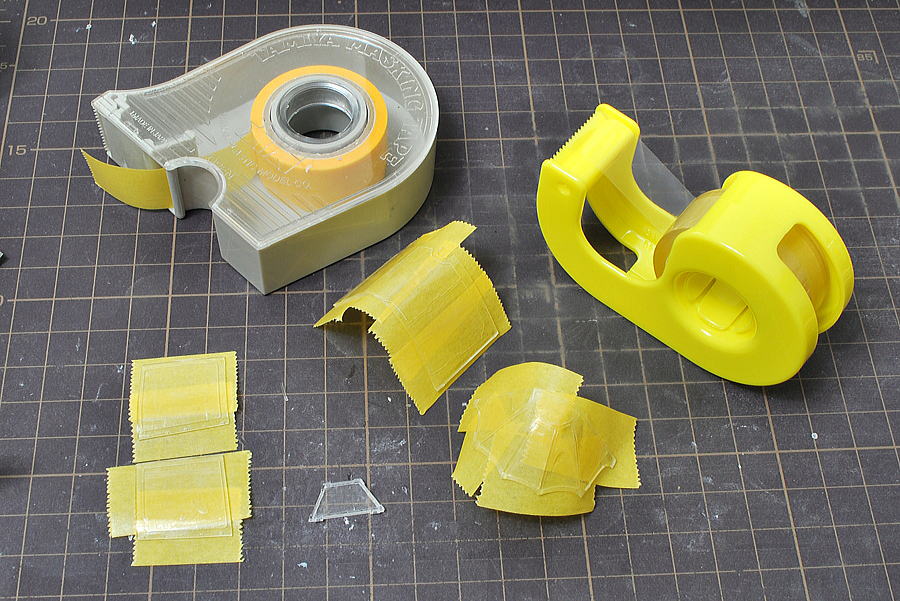 I used adhesive cellophane tape and cut the flame out for the outside of the canopy; inside is masking tape. The cellophane tape was too adhesive solid power and glue are sticking; next time, I’ll use mending tape.
I used adhesive cellophane tape and cut the flame out for the outside of the canopy; inside is masking tape. The cellophane tape was too adhesive solid power and glue are sticking; next time, I’ll use mending tape.
 After painting the lower body and masking it all.
After painting the lower body and masking it all.
 They have painted the primary body color and cowling color. 1/32 size is enormous; the painting is a piece of work.
They have painted the primary body color and cowling color. 1/32 size is enormous; the painting is a piece of work.
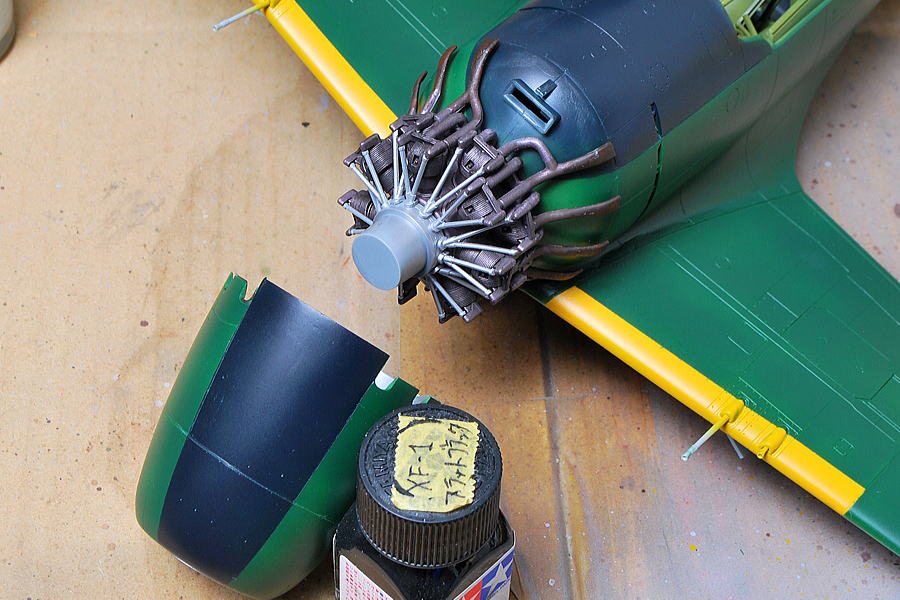 I joined the engine to the body; the engine mold is quite good.
I joined the engine to the body; the engine mold is quite good.
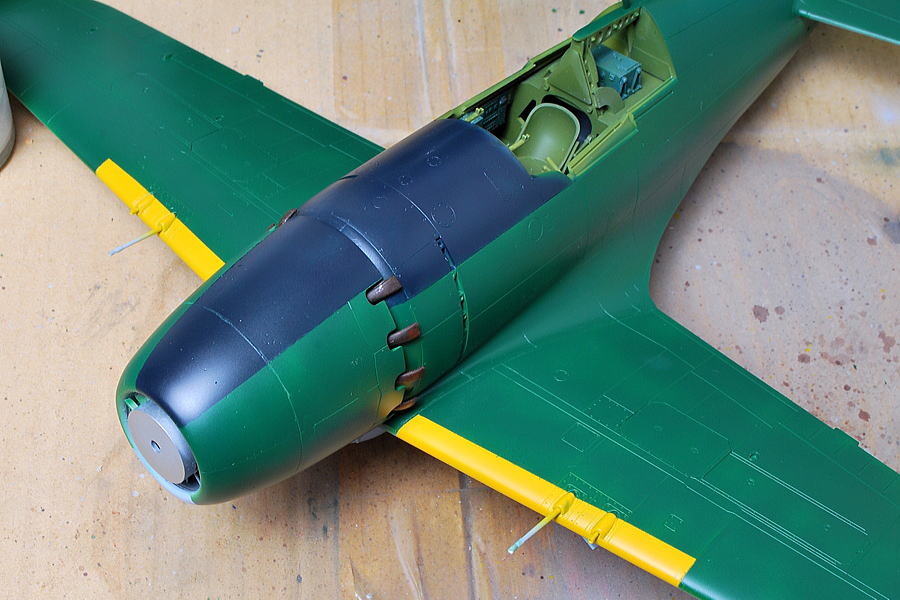 I stuffed up the engine cowling paint; I thought the panel line was a color-divided line without checking, but it was wrong; it needed to work again…
I stuffed up the engine cowling paint; I thought the panel line was a color-divided line without checking, but it was wrong; it needed to work again…
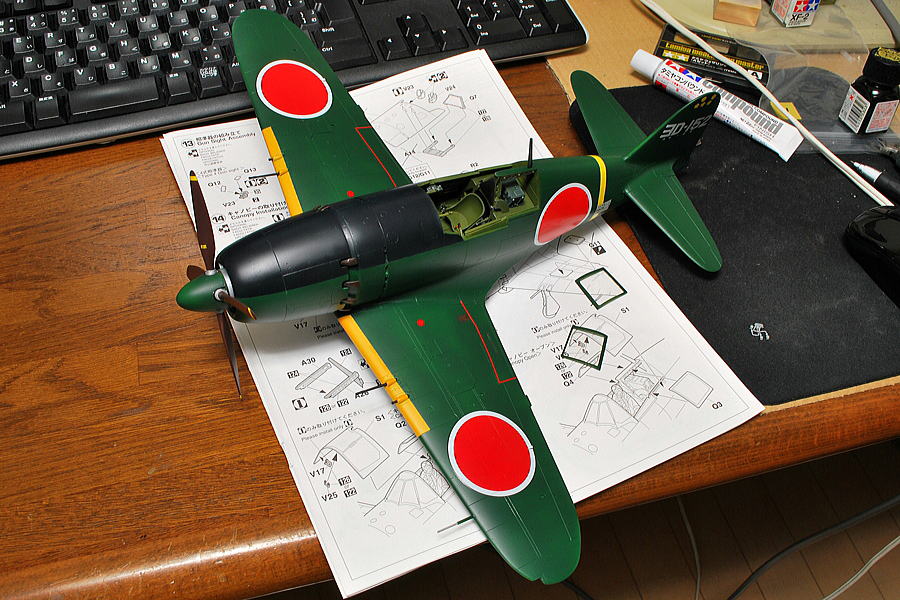 I used the body color Mr. Color #124, Dark Green (Mitsubishi), and cowling color Mr. Color #125.
I used the body color Mr. Color #124, Dark Green (Mitsubishi), and cowling color Mr. Color #125.
 The bottom color is Mr. Color #35 IJN Gray (Mitsubishi), as indicated in the instruction manual. The landing gear was attached, and the goal was almost there. (04-September-2014)
The bottom color is Mr. Color #35 IJN Gray (Mitsubishi), as indicated in the instruction manual. The landing gear was attached, and the goal was almost there. (04-September-2014)
![Raiden [Jack] Type21 Mitsubishi J2M3 Japanese Navy Interceptor Hasegawa 1/32 Raiden [Jack] Type21 Mitsubishi J2M3 Japanese Navy Interceptor Hasegawa 1/32](https://kenta2222.com/wp-content/uploads/raiden21-23.jpg) I finished up this Raiden (“Thunderbolt”). It’s a quick-climbing interceptor for air-base defense. It became the spindle shape body necessary to build the large and high-power engine.
I finished up this Raiden (“Thunderbolt”). It’s a quick-climbing interceptor for air-base defense. It became the spindle shape body necessary to build the large and high-power engine.
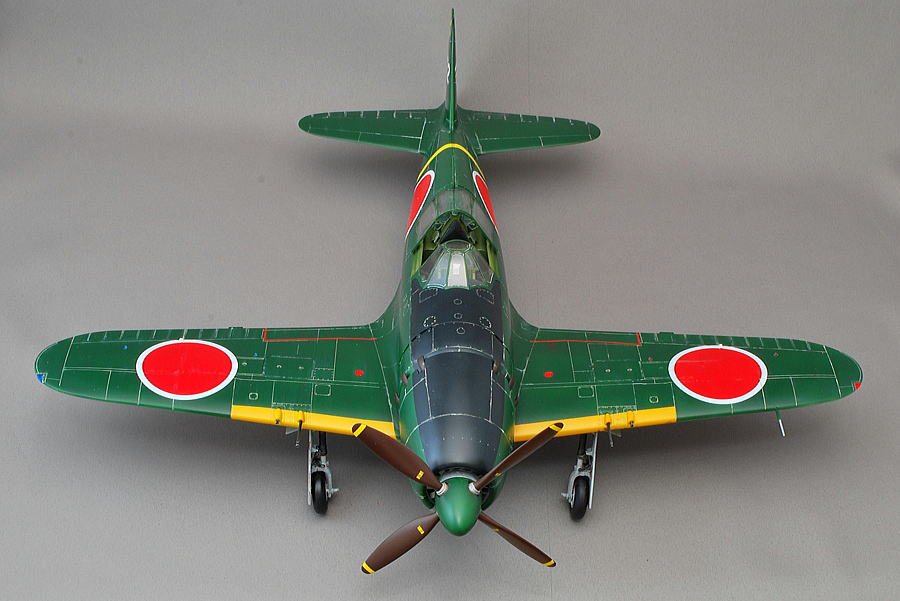 The Kasei engine was the most powerful in Japan and was used for large bombardment aircraft. Raiden-equipped forces are cooling fans behind the propeller in consideration of cooling efficiency falling by squeezing the nose.
The Kasei engine was the most powerful in Japan and was used for large bombardment aircraft. Raiden-equipped forces are cooling fans behind the propeller in consideration of cooling efficiency falling by squeezing the nose.
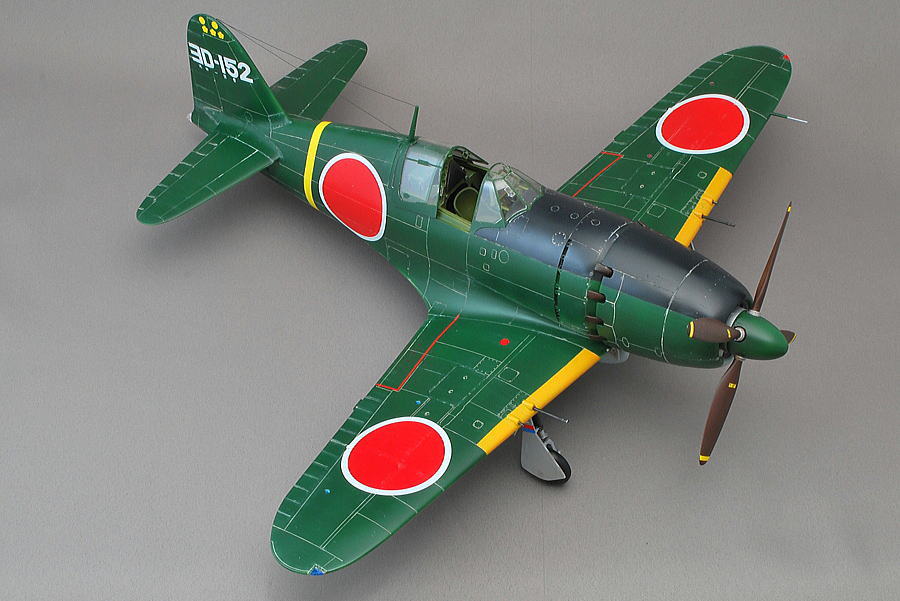 Mr. Jiro Horikoshi designed this fighter for an aviation engineer who is the subject of the famous Japanese animation movie “The Wind Rises” director Mr. Hayao Miyazaki, one of the top animation film directors.
Mr. Jiro Horikoshi designed this fighter for an aviation engineer who is the subject of the famous Japanese animation movie “The Wind Rises” director Mr. Hayao Miyazaki, one of the top animation film directors.
 I changed my mind during my painting, and no heavy weathering this time.
I changed my mind during my painting, and no heavy weathering this time.
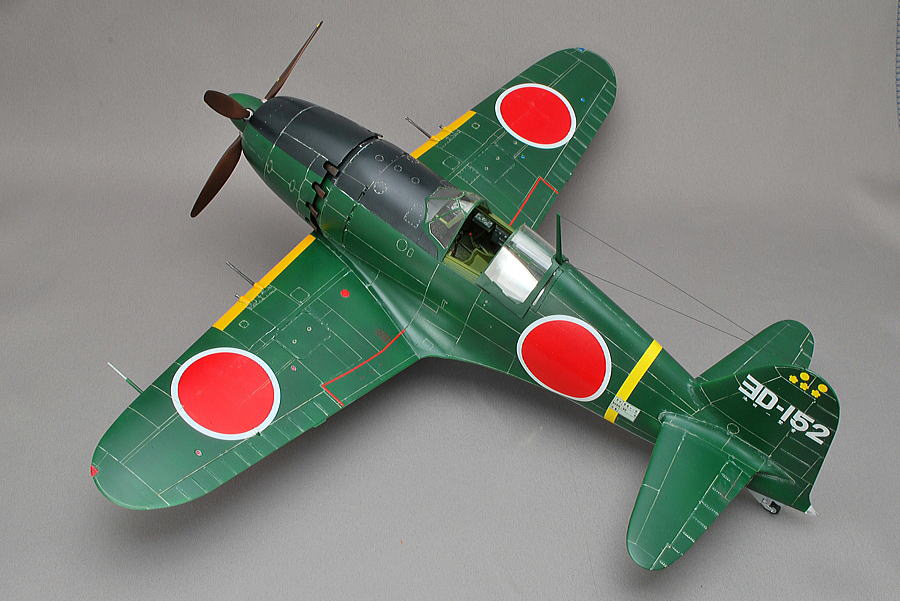 Though I am not satisfied without doing weathering when making AFV, regarding the airplane model, I am reluctant to make a dirty finish-up; it’s a mystery… Maybe after a couple of assembling works, I would like to do reality finishing.
Though I am not satisfied without doing weathering when making AFV, regarding the airplane model, I am reluctant to make a dirty finish-up; it’s a mystery… Maybe after a couple of assembling works, I would like to do reality finishing.
 Raiden’s cockpit is large, but difficult to take pictures inside.
Raiden’s cockpit is large, but difficult to take pictures inside.
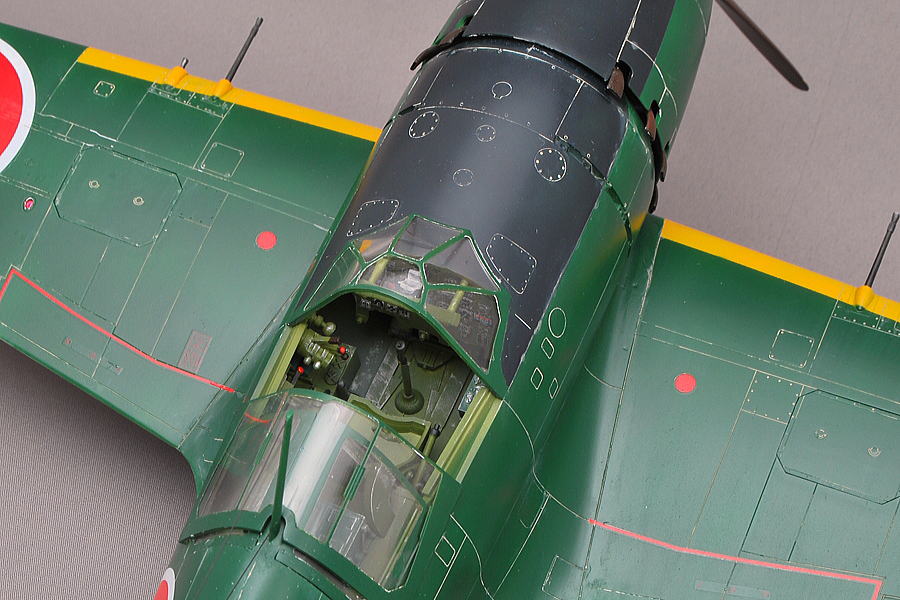 I arranged colors for some levers and switches in the cockpit. Finally, I did dry brushing with a metal color.
I arranged colors for some levers and switches in the cockpit. Finally, I did dry brushing with a metal color.
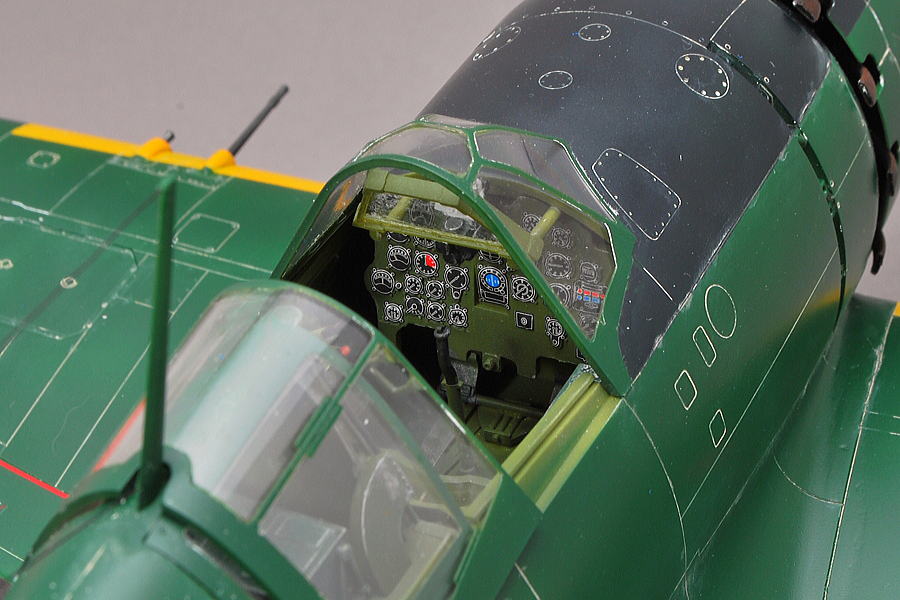 The dark color cowl prevents a reflection of the sunlight and keeps the view well. The principle is the same as a racing car’s bonnet is painted in dark colors.
The dark color cowl prevents a reflection of the sunlight and keeps the view well. The principle is the same as a racing car’s bonnet is painted in dark colors.
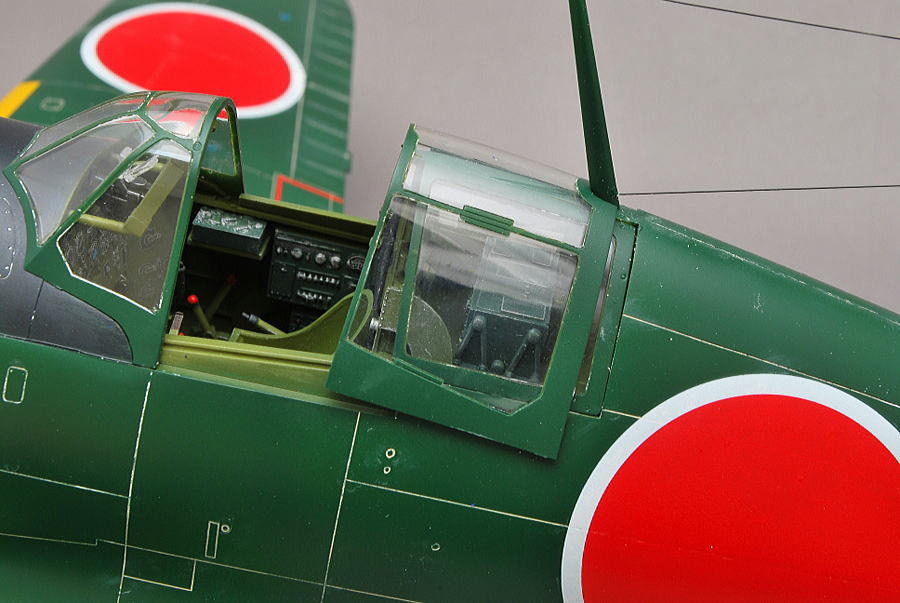 I polished the canopy with a compound.
I polished the canopy with a compound.
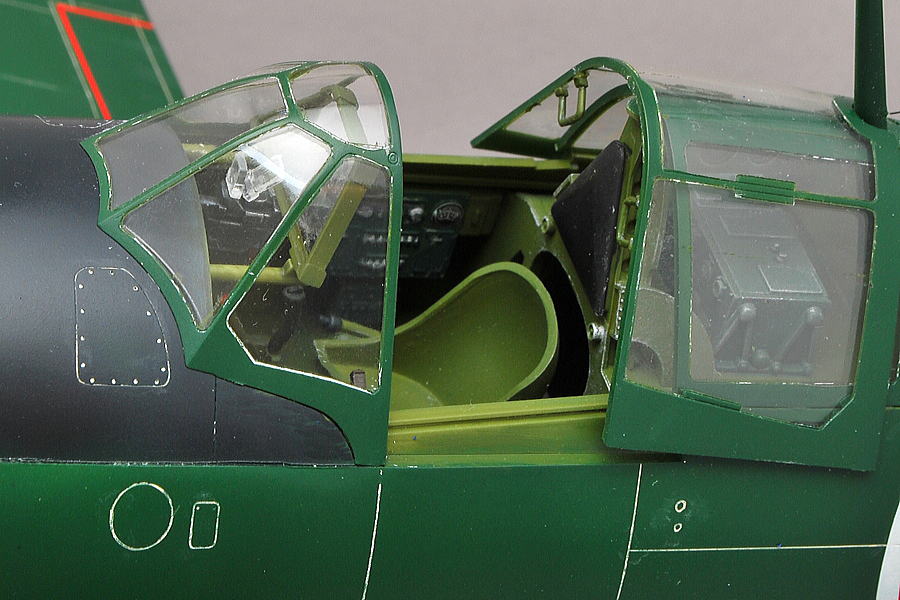 Over the front glass, we can see an optical gunsight device.
Over the front glass, we can see an optical gunsight device.
 I changed the main wing light to clear parts and painted it red; the right side is blue. I should have fit the parts more carefully. Anyway, the reality is a little up for this change.
I changed the main wing light to clear parts and painted it red; the right side is blue. I should have fit the parts more carefully. Anyway, the reality is a little up for this change.
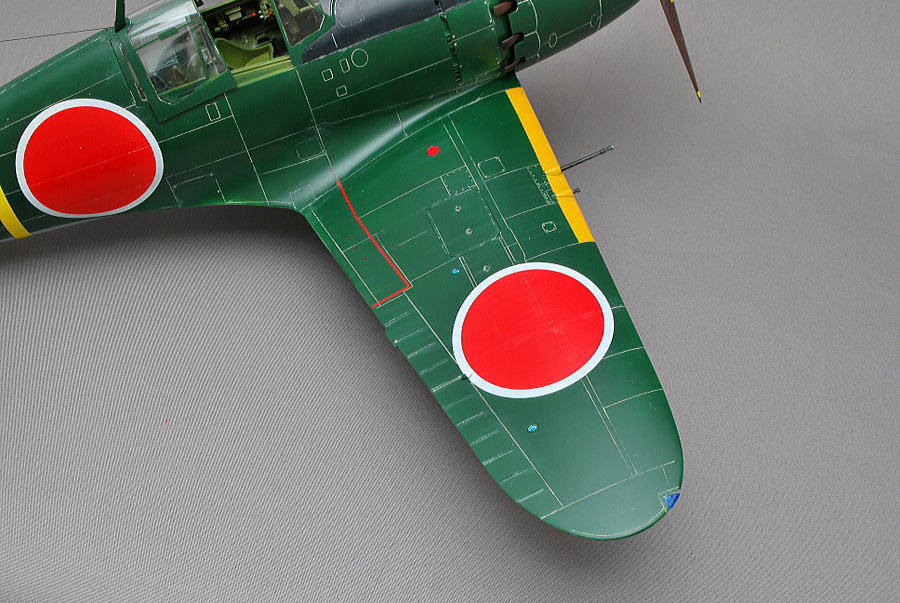 I already decided not to do heavy weathering, and the only canopy with dust weathering is unnatural; I left it alone. I used clear epoxy glue to attach the canopy. Slide canopy’s inside of the left side; I mistakenly stuck a tiny glue stain…, poignant regret.
I already decided not to do heavy weathering, and the only canopy with dust weathering is unnatural; I left it alone. I used clear epoxy glue to attach the canopy. Slide canopy’s inside of the left side; I mistakenly stuck a tiny glue stain…, poignant regret.
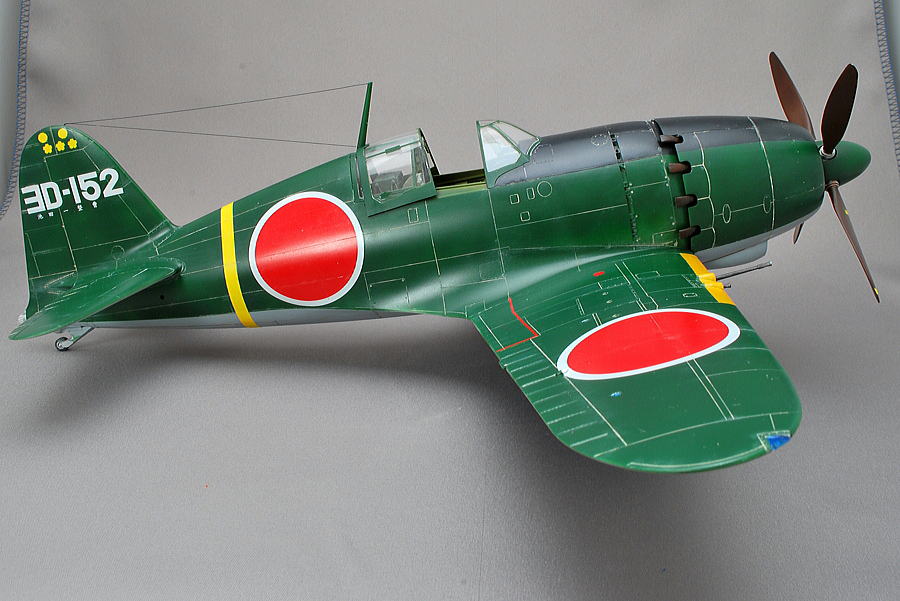 Aerial wires are a fishing line that I used last year. Line number 0.6 and diameter is 0.128mm. It’s my first model to work aerial wire.
Aerial wires are a fishing line that I used last year. Line number 0.6 and diameter is 0.128mm. It’s my first model to work aerial wire.
 The armament is a 20mm machine gun x 4; It could destroy the B-29 invasion in a single blow. Anyway, I can say the firepower was really heavy and effective.
The armament is a 20mm machine gun x 4; It could destroy the B-29 invasion in a single blow. Anyway, I can say the firepower was really heavy and effective.
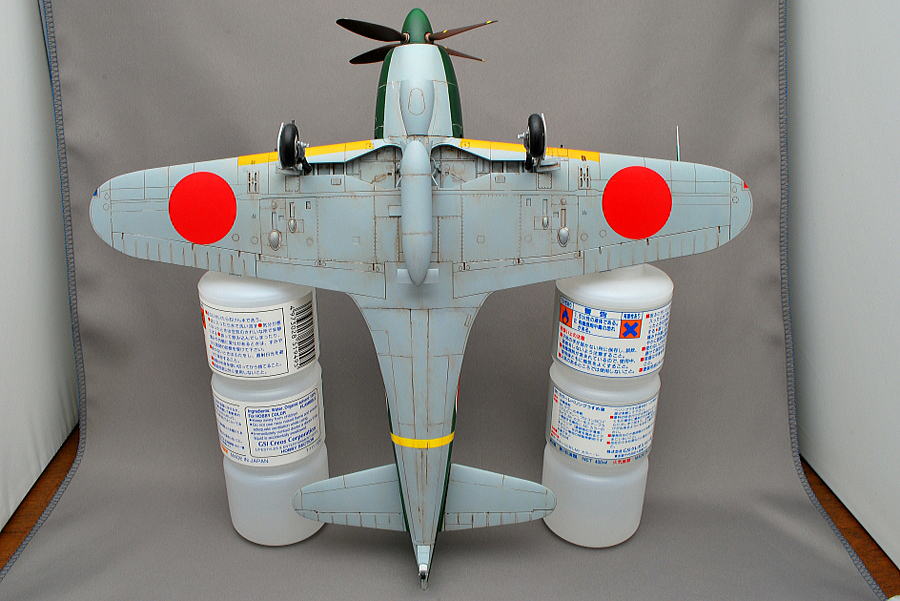 I did ink in the panel line and washed lightly.
I did ink in the panel line and washed lightly.
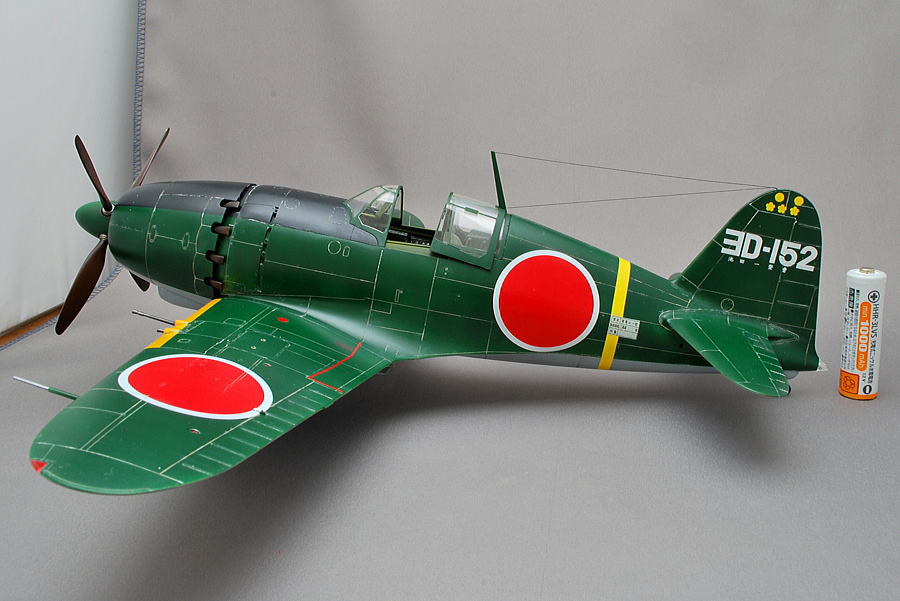 Even if it’s a single-engine fighter, the 1/32 scale size is large compared to the AA battery. Too big for my photo booth.
Even if it’s a single-engine fighter, the 1/32 scale size is large compared to the AA battery. Too big for my photo booth.
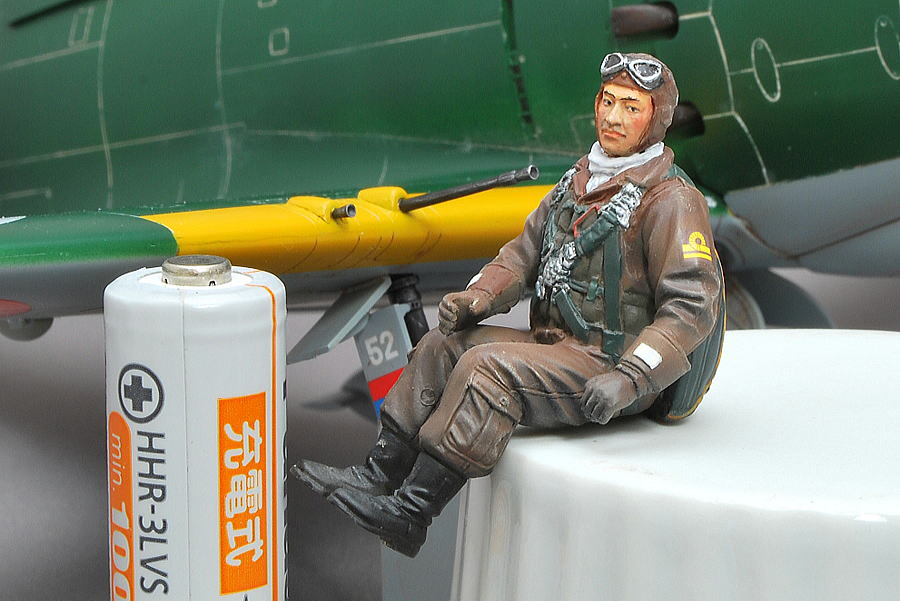 The sculptor is good. He looks Japanese with excellent facial expressions. It’s challenging to paint on this small face. And I could paint very well, I suppose. I forgot to delete the injection mark on the right foot, but he is in the cockpit, so this time it’s OK; next time, I’ll be careful no remaining these marks.
The sculptor is good. He looks Japanese with excellent facial expressions. It’s challenging to paint on this small face. And I could paint very well, I suppose. I forgot to delete the injection mark on the right foot, but he is in the cockpit, so this time it’s OK; next time, I’ll be careful no remaining these marks.
 He carries an emergency parachute on his back.
He carries an emergency parachute on his back.
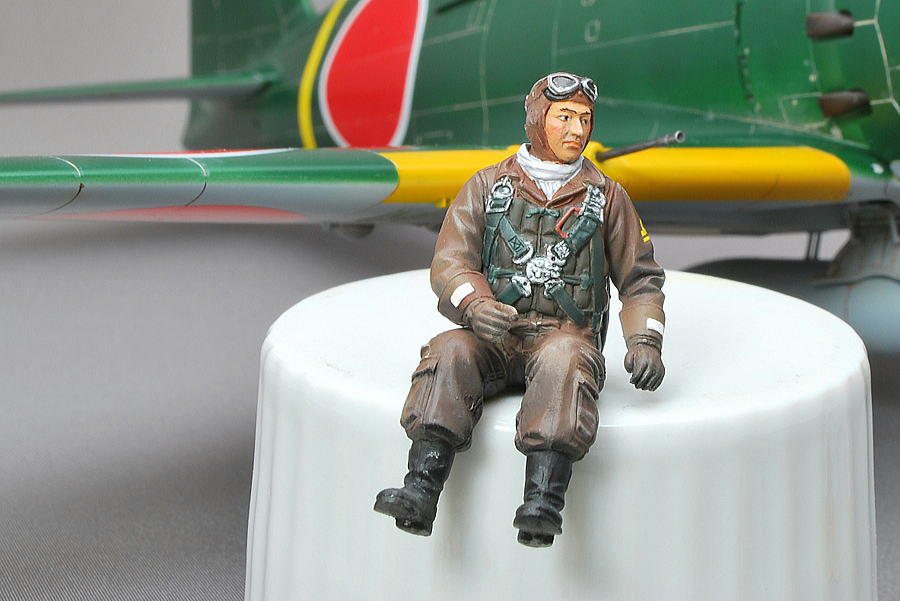 These silver parachute tags are a good accent for this figure.
These silver parachute tags are a good accent for this figure.
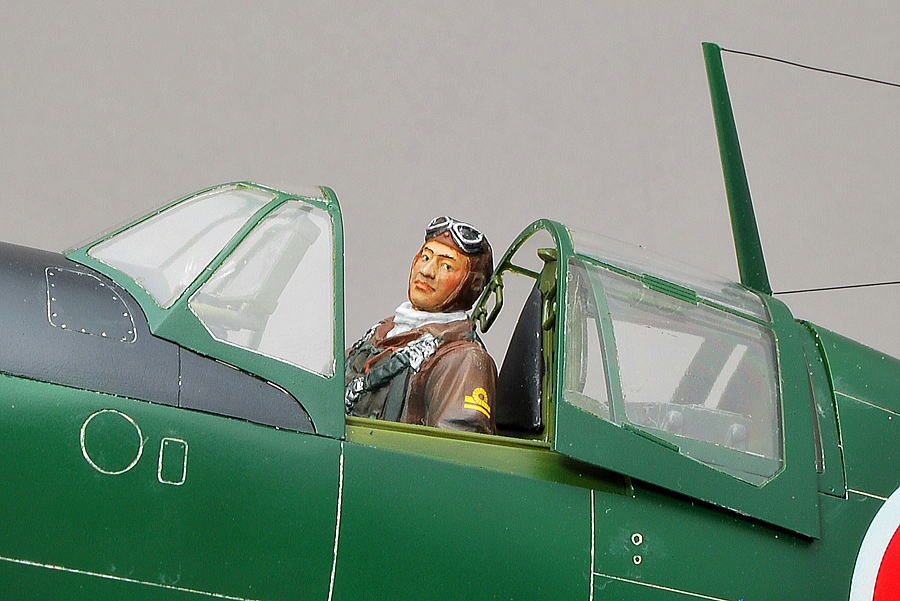 It’s excellent for a pilot sitting in the cockpit and seeing outside. He is almost flying off.
It’s excellent for a pilot sitting in the cockpit and seeing outside. He is almost flying off.
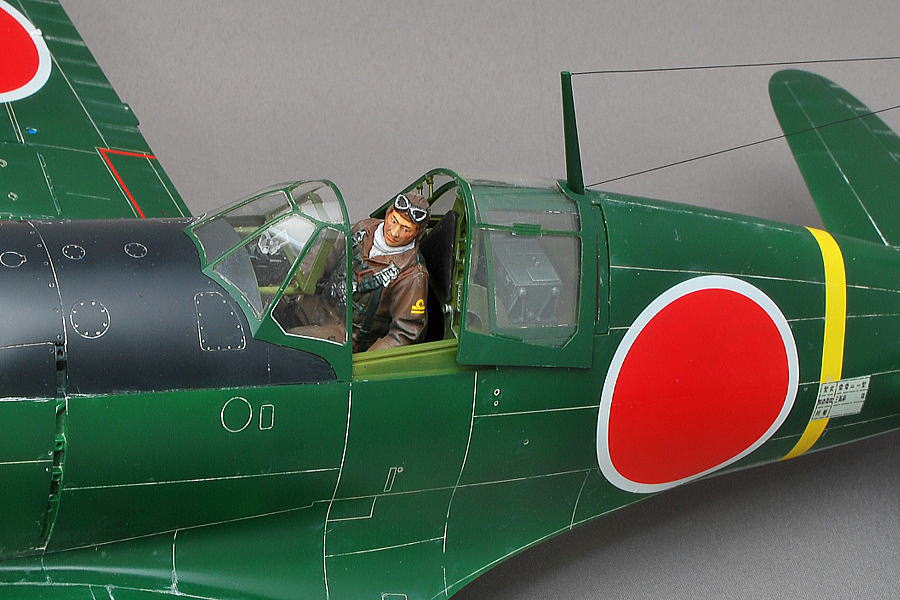 Homeland defense. There is no doubt that he would do it for us.
Homeland defense. There is no doubt that he would do it for us.
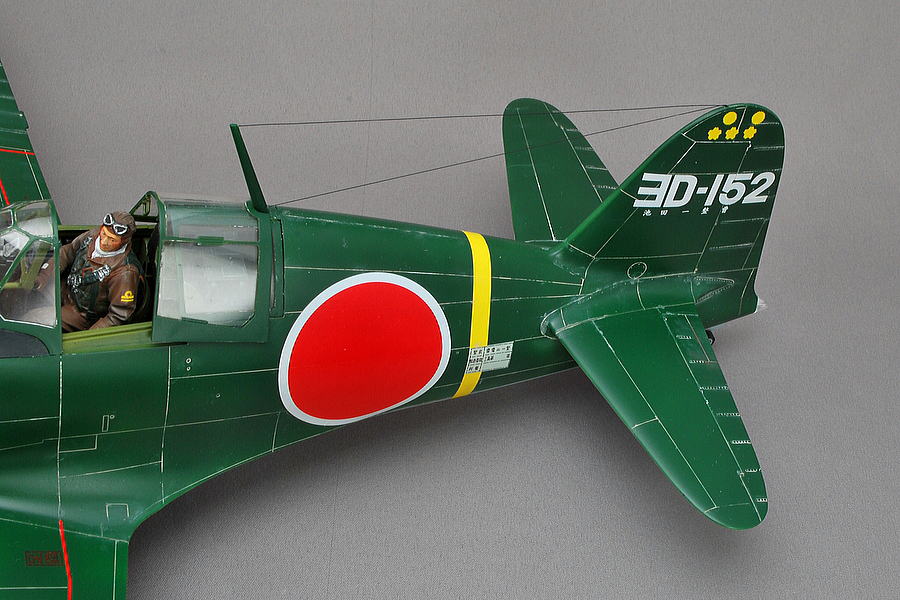 I want to make this scale again. This time, I have some reflection points. Mistakes occurred in the essential work and painting and were not perfectly matched my imagination. The parts that finished were rough to have appeared. Even with some mistakes, this 1/32 scale kit is powerful, and its presence differs from 1/48 and 1/72. It is a feeling that the best-looking distance is around 50cm.
I want to make this scale again. This time, I have some reflection points. Mistakes occurred in the essential work and painting and were not perfectly matched my imagination. The parts that finished were rough to have appeared. Even with some mistakes, this 1/32 scale kit is powerful, and its presence differs from 1/48 and 1/72. It is a feeling that the best-looking distance is around 50cm.
(08-September-2014)
![Raiden [Jack] Type21 Mitsubishi J2M3 Japanese Navy Interceptor Hasegawa 1/32 Raiden [Jack] Type21 Mitsubishi J2M3 Japanese Navy Interceptor Hasegawa 1/32](https://i3.wp.com/kenta2222.com/wp-content/uploads/raiden21-23.jpg?w=900&resize=900,600&ssl=1)


コメント